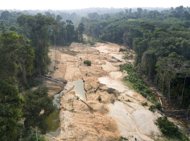Gold rush sweeps Latin America, Amazon suffers

With international market prices for metals high, informal "wildcat" mining has been on the rise in recent years in countries like Bolivia, Colombia and Peru, itself one of the largest producers of silver, copper and gold.
Mining investments in those countries are expected to reach some $300 billion in 2020, according to the Inter-American Mining Society.
But over 160 mining conflicts have erupted across the region amid growing opposition from locals against projects they consider a threat to the environment, the Observatory of Mining Conflicts in Latin America says.
During the past decade, the price of gold went from $270 to between $1,600-1,800 per ounce, as people rushed to convert their cash into the precious metal seen as a safe investment during the global economic crisis.
And the price of copper is at an all-time high thanks to China's insatiable appetite for it.
Unlicensed mining, especially for gold, has already killed hundreds of people and devastated thousands of hectares (acres) in the Amazon forest, where miners have set up camps that destroy everything in their path.
To extract each ounce of gold, it takes two or three ounces of mercury, which fouls waterways after being poured into rivers from the mining sites. In their search for water, the miners raze tropical forests using bulldozers.
The phenomenon has also sown disaster among the local population, with thousands of men, women and children exploited and living in squalid camps with no schools or health centers.
In Peru, an estimated 110,000 to 150,000 people work in illegal mines, while a thousand children are sexually exploited in brothels known locally as "prostibars" in the southeastern province of Madre de Dios, according to Save The Children.
The practice is particularly widespread in the improvised mining camps, where fortune-hunter try to make a living from the illegal exploitation of precious metals.
"There are dozens of prostibars, filled with hundreds of girls who were told they would make a lot of money," said Teresa Carpio, director of Save the Children in Peru.
"It's total exploitation of a human being. Living conditions are appalling and all human values are perverted."
Indigenous and black communities have long used child workers for gold mining. And an estimated 200,000 to 400,000 children currently work in small-scale mining in Colombia, according to Alliance for Responsible Mining (ARM) data.
In Madre de Dios, one of the poorest regions of Peru, about 18 tonnes of gold are produced per year, while some 20,000 hectares (49,400 acres) of tropical forest are destroyed.
Thousands of people in Colombia have started exploiting abandoned mines in the northwestern department of Antioquia and Choco. In Bolivia, about 10,000 people make a living off the illegal mining of gold in extreme conditions, ARM says.
The growing thirst for mineral resources makes Latin America one of the most attractive regions for investment, set to dominate world production of precious metals by 2020.
Today, Latin America accounts for 45 per cent of global copper production, 50 per cent of silver and 20 per cent of gold.
But several commercial mining projects have been put on hold in Chile, Peru and Argentina, as local communities have fought for their rights to prior consultation under the International Labor Organization's Indigenous and Tribal Peoples Convention.
The Peruvian government is finalizing a deal with US mining giant Newmont about a proposed $4.8 billion gold mine that has sparked violent protests.
The Conga project was suspended last year after a worker strike over adverse environmental impacts that many in the region fear will result from the planned mining project in the Cajamarca area of northern Peru.
In the northern Argentine town of Famatina, Canada's Osisko Mining Corp had to put its open pit gold mining project on hold after protests due to concerns over water consumption and pollution.
Canadian mining group Goldcorp had to stop work at Chile's northern El Morro mine, which holds promising gold and copper reserves, for not having consulted indigenous populations.
"It is necessary that the economic model and productive activities comply with current legislation, that development is sustainable and consistent with the rights of the people who inhabit the areas they want to exploit," said Consuelo Labra of the Citizen Observatory in Chile.
What the stars mean:
★ Poor ★ ★ Promising ★★★ Good ★★★★ Very good ★★★★★ Exceptional
Related Contents
Latest News
More News
- UN Secretary-General commends Vietnam’s global leadership (October 26, 2025 | 09:00)
- APEC finance ministers convene to tackle regional challenges (October 22, 2025 | 17:31)
- Rewiring global trade: ASEAN’s rise as supply chain hub (October 17, 2025 | 11:40)
- Vietnam attends first World Nuclear Week Forum in Russia (September 26, 2025 | 10:50)
- Vietnam attends 69th session of IAEA General Conference (September 16, 2025 | 10:00)
- ADB, WB pledge over 12 billion USD for ASEAN power grid, renewable energy projects (August 15, 2025 | 14:18)
- Lowy Institute proposes AI-based tobacco control solutions for ASEAN (August 15, 2025 | 14:14)
- Cloud computing policy to position Malaysia as regional hub by 2030 (August 15, 2025 | 14:11)
- Thailand, Cambodia suffer numerous cyber attacks (August 05, 2025 | 16:19)
- Vietnam sets sights on regional leadership on 30th ASEAN anniversary (August 01, 2025 | 15:09)

 Tag:
Tag:






















 Mobile Version
Mobile Version